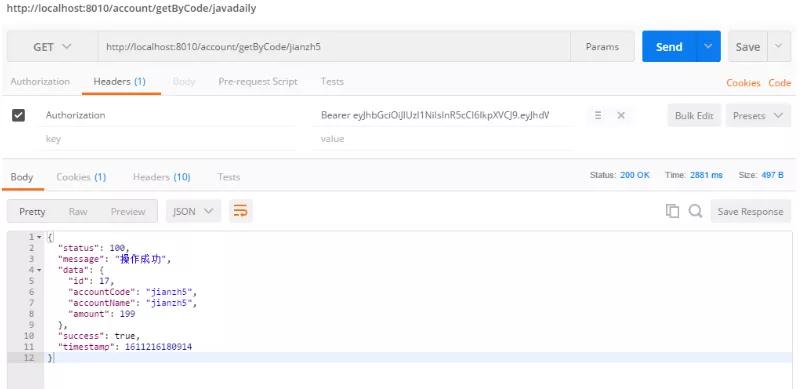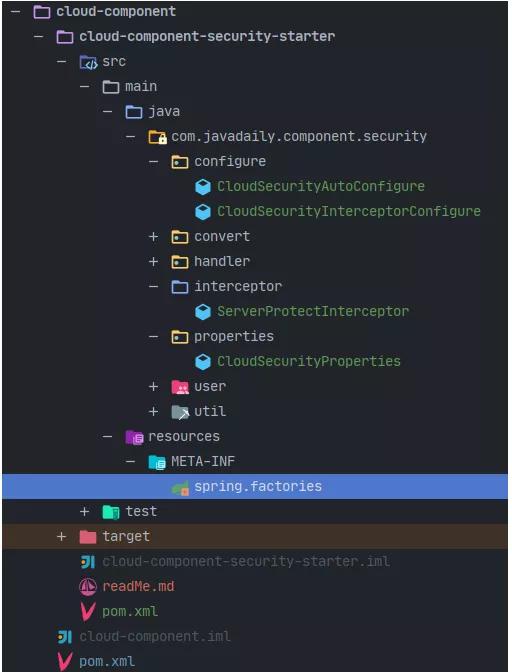本文转载自微信公众号「JAVA日知录」,作者单一色调 。转载本文请联系JAVA日知录公众号。
前言
使用SpringCloud架构后我们希望所有的请求都需要经过网关才能访问,在不作任何处理的情况下我们是可以绕过网关直接访问后端服务的。如下,我们绕过网关直接访问后端服务也是可以获取到数据的。
那我们今天的议题就是 如何防止请求绕过网关直接访问后端服务?
解决方案
我觉得防止绕过网关直接请求后端服务的解决方案主要有三种:
- 使用Kubernetes部署
在使用Kubernetes部署SpringCloud架构时我们给网关的Service配置NodePort,其他后端服务的Service使用ClusterIp,这样在集群外就只能访问到网关了。
- 网络隔离
后端普通服务都部署在内网,通过防火墙策略限制只允许网关应用访问后端服务。
- 应用层拦截
请求后端服务时通过拦截器校验请求是否来自网关,如果不来自网关则提示不允许访问。
这里我们着重关注在应用层拦截这种解决方案。
实现思路
实现思路其实也很简单,在请求经过网关的时候给请求头中增加一个额外的Header,在后端服务中写一个拦截器,判断请求头是否与在网关设置的请求Header一致,如果不一致则不允许访问并给出提示。
当然为了防止在每个后端服务都需要编写这个拦截器,我们可以将其写在一个公共的starter中,让后端服务引用即可。而且为了灵活,可以通过配置决定是否只允许后端服务访问。
接下来我们看看核心代码。(代码中涉及 SpringBoot 编写公共Starter的套路,相信看过我博客的同学肯定是会的,因为之前文章有详细说过。)
实现过程
在网关cloud-gateway模块编写网关过滤器
- @Component
- @Order(0)
- public class GatewayRequestFilter implements GlobalFilter {
- @Override
- public Mono<Void> filter(ServerWebExchange exchange, GatewayFilterChain chain) {
- byte[] token = Base64Utils.encode((CloudConstant.GATEWAY_TOKEN_VALUE).getBytes());
- String[] headerValues = {new String(token)};
- ServerHttpRequest build = exchange.getRequest()
- .mutate()
- .header(CloudConstant.GATEWAY_TOKEN_HEADER, headerValues)
- .build();
- ServerWebExchange newExchange = exchange.mutate().request(build).build();
- return chain.filter(newExchange);
- }
- }
在请求经过网关时添加额外的Header,为了方便这里直接设置成固定值。
建立公共Starter模块cloud-component-security-starter
- 编写配置类,用于灵活控制服务是否允许绕过网关
- @Data
- @ConfigurationProperties(prefix = "javadaily.cloud")
- public class CloudSecurityProperties {
- /**
- * 是否只能通过网关获取资源
- * 默认为True
- */
- private Boolean onlyFetchByGateway = Boolean.TRUE;
- }
- 编写拦截器,用于校验请求是否经过网关
- public class ServerProtectInterceptor implements HandlerInterceptor {
- private CloudSecurityProperties properties;
- @Override
- public boolean preHandle(@NonNull HttpServletRequest request, @NonNull HttpServletResponse response, @NonNull Object handler){
- if (!properties.getOnlyFetchByGateway()) {
- return true;
- }
- String token = request.getHeader(CloudConstant.GATEWAY_TOKEN_HEADER);
- String gatewayToken = new String(Base64Utils.encode(CloudConstant.GATEWAY_TOKEN_VALUE.getBytes()));
- if (StringUtils.equals(gatewayToken, token)) {
- return true;
- } else {
- ResultData<String> resultData = new ResultData<>();
- resultData.setSuccess(false);
- resultData.setStatus(HttpServletResponse.SC_FORBIDDEN);
- resultData.setMessage("请通过网关访问资源");
- WebUtils.writeJson(response,resultData);
- return false;
- }
- }
- public void setProperties(CloudSecurityProperties properties) {
- this.properties = properties;
- }
- }
- 配置拦截器
- public class CloudSecurityInterceptorConfigure implements WebMvcConfigurer {
- private CloudSecurityProperties properties;
- @Autowired
- public void setProperties(CloudSecurityProperties properties) {
- this.properties = properties;
- }
- @Bean
- public HandlerInterceptor serverProtectInterceptor() {
- ServerProtectInterceptor interceptor = new ServerProtectInterceptor();
- interceptor.setProperties(properties);
- return interceptor;
- }
- @Override
- public void addInterceptors(InterceptorRegistry registry) {
- registry.addInterceptor(serverProtectInterceptor());
- }
- }
- 编写starter装载类
- @EnableConfigurationProperties(CloudSecurityProperties.class)
- public class CloudSecurityAutoConfigure{
- @Bean
- public CloudSecurityInterceptorConfigure cloudSecurityInterceptorConfigure() {
- return new CloudSecurityInterceptorConfigure();
- }
- }
- 建立资源文件spring.factories,配置Bean的自动加载
- org.springframework.boot.autoconfigure.EnableAutoConfiguration=\
- com.javadaily.component.security.configure.CloudSecurityAutoConfigure
在后端服务配置文件中添加属性配置,默认只能通过网关访问
- javadaily:
- cloud:
- onlyFetchByGateway: true
经过以上几步,一个公共的Starter模块就构建完成了。
后端服务引用此公共Starter模块即可,以account-service为例
- <dependency>
- <groupId>com.jianzh5.cloud</groupId>
- <artifactId>cloud-component-security-starter</artifactId>
- </dependency>
实现效果
直接访问后端服务接口
http://localhost:8010/account/getByCode/jianzh5
返回结果:
- "message": "请通过网关访问资源",
- "status": 403,
- "success": false,
- "timestamp": 1611660015830
- }


































